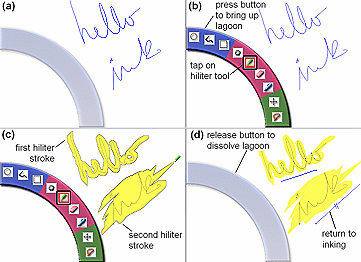springboard
microsoft research
|
up patrick baudisch |
| stitching video (mov 61MB) publications |

|
Fig. 1. Illustration of the Springboard using a tool lagoon with icons. (a) Inking is the default. (b) The user holds down a non-preferred hand button to call up the lagoon, and taps the highliter tool. (c) Pen strokes apply the highliter as long as the user holds the button. (d) Releasing the button returns to inking. |
Modes allow a few inputs to invoke many operations, yet if a user misclassifies or forgets the state of a system, modes can result in errors. Spring-loaded modes (quasi modes) maintain a mode while the user holds a control such as a button or key. The Springboard is an interaction technique for tablet computers that extends quasi modes to encompass multiple tool modes in a single spring-loaded control. The Springboard allows the user to continue holding down a non-preferred hand command button after selecting a tool from a menu as a way to repeatedly apply the same tool. We find the Springboard improves performance for both a local marking menu and for a non-local marking menu (“lagoon”) at the lower left corner of the screen. Despite the round-trip costs incurred to move the pen to a tool lagoon, a keystroke-level analysis of the true cost of each technique reveals the local marking menu is not significantly faster.
|
publication about the springboard |
||
|
Project in collaboration with Ken Hinckley (principal investigator) and others.